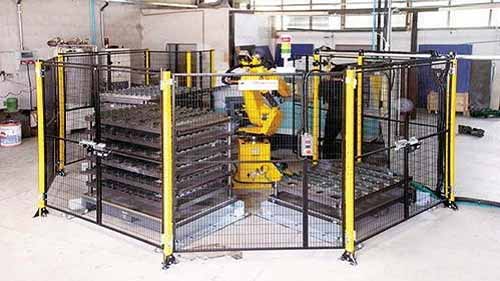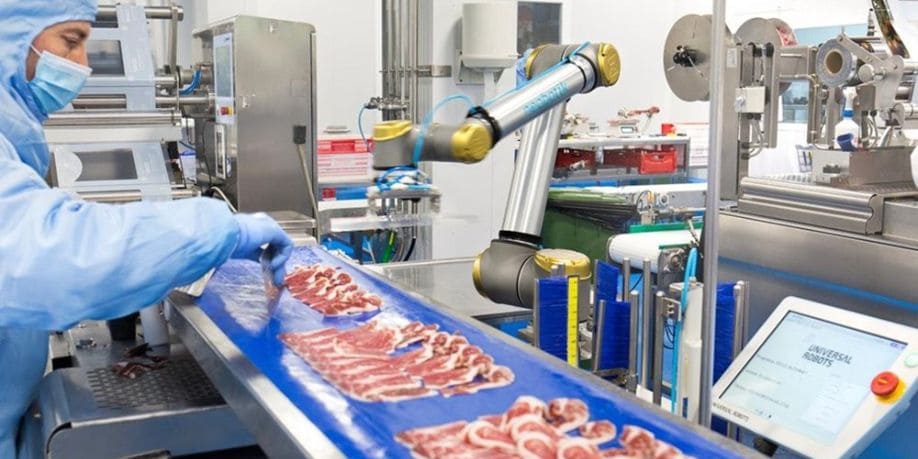In recent years, collaborative robots—or simply cobots—have revolutionized modern industry. Unlike traditional industrial robots, cobots are designed to work directly alongside human operators, without rigid barriers separating them.
However, this collaboration does not eliminate the need for specific protective measures. Quite the contrary: adequate protection not only safeguards human safety but also extends the cobot’s lifespan, ensures regulatory compliance, and optimizes process efficiency.
Want to know the key requirements you should consider? We’ll explain them below.


Why are safeguards necessary for collaborative robots?
Although cobots are designed to minimize risks, they are not infallible. Small programming errors, miscalibrated sensors, or simple human inadvertent actions can lead to serious accidents if adequate safeguards are not in place.
Furthermore, current regulations, such as ISO/TS 15066, require the implementation of active and passive safeguards for cobots in all industrial environments. Essentially, this is not just a matter of safety, but also of legal liability and business competitiveness.
Properly protecting a cobot also protects the performance of an entire production line.
Types of risks faced by cobots
Identifying risks is the first step in designing an effective protection system. The main hazards associated with cobots include:
● Accidental collisions: Despite their sensors, a programming error or prediction error can cause the cobot to collide with an operator.
● Mechanical entrapment: Articulation or movement areas can create spaces where fingers or hands can become trapped.
● Repetitive strain: Continuous contact with the cobot can cause muscle injuries.
● Cross-contamination: In sectors such as pharmaceuticals or food, cobot-human interaction must ensure maximum cleanliness.
Each of these risks requires specific and customized protections.
Physical guards: essential elements for cobots
Identifying risks is the first step in designing an effective protection system. The main hazards associated with cobots include:
● Accidental collisions: Despite their sensors, a programming error or prediction error can cause the cobot to collide with an operator.
● Mechanical entrapment: Articulation or movement areas can create spaces where fingers or hands can become trapped.
● Repetitive strain: Continuous contact with the cobot can cause muscle injuries.
● Cross-contamination: In sectors such as pharmaceuticals or food, cobot-human interaction must ensure maximum cleanliness.
Each of these risks requires specific and customized protections.


Key international regulations for cobot protection
Complying with international regulations is not optional if you want to operate without legal risks. The main standards are:
● ISO 10218-1 and 10218-2: These establish general safety requirements for industrial robots.
● ISO/TS 15066: Defines safe limits of force, pressure, and speed in human-robot collaboration.
These regulations not only seek to protect workers but also to standardize international quality and safety standards.
Ergonomic design of cobot guards
Guards must be safe, yes, but also practical. Ergonomics cannot be sacrificed in the name of safety.
Therefore, modern cobot guards include:
● Smooth, rounded, and easy-to-clean surfaces.
● Lightweight materials to avoid impairing mobility.
● Quick-attachment systems for easy maintenance.
Good guards should be intuitive and not hinder human-machine interaction.
Importance of risk analysis for cobots
There is no standard protection for all cobots. Each application, environment, and task requires a customized risk analysis, which must consider:
● Movement types and speeds.
● Workloads and forces generated.
● Frequency and intensity of human contact.
Failing to perform a proper analysis is like navigating without a compass. It may turn out well… but the odds are not in your favor.
Common mistakes when protecting collaborative robots
Some common mistakes to avoid:
● Overprotection: Unnecessarily limits productivity.
● Generic protections: Not adapted to the cobot’s actual use.
● Forgetting maintenance: Safety systems also wear out.
The right solution is always a balance between safety, agility, and durability.
Specific guard requirements by application
Protecting a cobot performing light assembly is not the same as protecting one that welds at high temperatures. Each application requires:
● Heat-resistant guards for welding.
● High-hygiene seals in the pharmaceutical industry.
● Ultra-fast response time for pick & place tasks.
Adapting guards to the process increases their effectiveness.
What materials are ideal for cobot guards?
The material is a key factor in ensuring the guards’ durability and effectiveness. Some of the most commonly used are:
● Reinforced polyurethane: flexible and highly impact-resistant.
● Flexible PVC: economical and with good chemical resistance.
● Polycarbonate: ideal for transparent and highly rigid guards.
● Stainless steel: essential in harsh or high-hygiene environments.
Choosing the right material ensures years of reliable protection.
Cobots in food and pharmaceutical environments: additional requirements
When it comes to sensitive industries, the requirements are even greater:
● Smooth, non-porous protection.
● Chemical-resistant materials.
● Ease of cleaning and disinfection.
In these sectors, poor protection can be catastrophic, not only for production but also for public health.


Future trends in protection for collaborative robots
The future points toward increasingly intelligent protections, where we will see:
● Materials that self-repair small cracks.
● Cobots capable of learning from accident patterns.
● Invisible protections based on electromagnetic fields.
Safety will no longer be merely reactive: it will be predictive and adaptive.
Integrating protection without losing productivity
The great paradox: greater security without sacrificing efficiency. The solution lies in:
● Designing modular and flexible protections.
● Using smart sensors to define dynamic zones.
● Planning scheduled, non-reactive maintenance.
A protected, productive, and agile cobot is now an achievable reality.
Cost of not protecting a collaborative robot
Failing to adequately protect a cobot means:
● Constant occupational risks.
● Exorbitant downtime costs.
● Loss of corporate image.
The equation is simple: protection is always cheaper than repair.
Conclusion: Investing in smart protections means investing in the future.
In an environment where human-machine collaboration is intensifying every day, it’s not enough to rely on good intentions. Protecting your cobots means protecting your company.
Investing in smart, dynamic, and certified protections means investing in the continuity, competitiveness, and future of your industrial plant.
Ready to take the next step in protecting your collaborative robots?
Contact us today and discover solutions tailored to your project.

